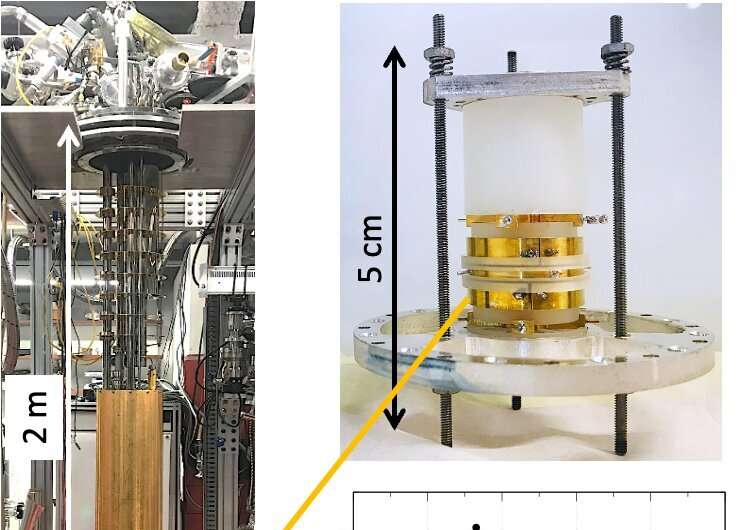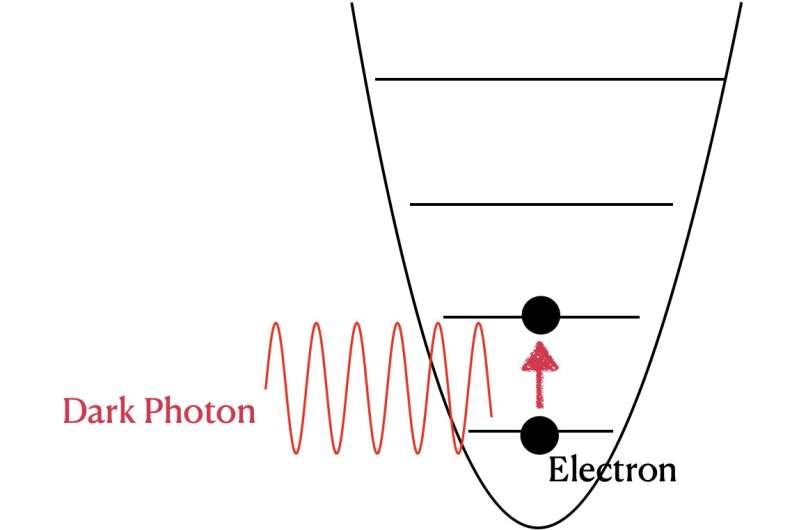January 25, 2023 feature
This article has been reviewed according to Science X's editorial process and policies. Editors have highlighted the following attributes while ensuring the content's credibility:
fact-checked
peer-reviewed publication
trusted source
proofread
Study demonstrates a new method to search for meV dark photons

Approximately 85% of the mass of our galaxy is comprised by dark matter, matter that does not emit, absorb or reflect light and thus cannot be directly observed. While several studies have hinted at or theorized about its composition, it remains one of the greatest unresolved physics problems.
Physicists all over the world have been conducting dark matter searches or trying to come up with new methods to directly observe different dark matter candidates. One hypothetical form of dark matter that has so far eluded detection is dark-photon dark matter.
An intriguing possibility is that dark matter is comprised of dark photons, which resemble photons (i.e., the particles that make up visible light), but interact with charges with feeble strength. These dark photons could theoretically have masses in the milli-electrovolt range, approximately a million times lighter than those of electrons and thus notoriously difficult to detect.
Researchers at Northwestern University, Stanford University and Fermilab have recently introduced a new method that could be used to search for meV dark photons. The validity of method, outlined in a paper published in Physical Review Letters, was demonstrated in a short proof-of-principle trial, which also helped to set new constraints on dark-photon dark matter.
"The idea for our study arose from discussions between experimenters and theorists facilitated by the DOE SQMS Center," Gabriel Gabrielse, one of the researchers who carried out the study, told Phys.org. "At Northwestern we were looking for BSM applications for an unusual one-electron detector that was background free. We had developed the novel detector to measure the electron electric dipole moment and test the Standard Model'ss most precise prediction."

After learning about the work carried out by Gabrielse and his colleagues at Northeastern, a team of theoretical physicists at Stanford reached out and pointed out the potential of their detector for conducting meV dark photon searches. This sparked a series of interactions and collaborations between the two research groups, also including Roni Harnik, a theorist at Fermilab.
The new method introduced by the researchers is based on the use of trapped electrons as high-Q resonators for detecting meV dark photon dark matter. Its underlying hypothesis is that when the rest energy of a dark photon matches the energy splitting of the two lowest cyclotron levels, the first state of the electron cyclotron will be excited.
"If a meV dark photon enters the trap in which a single electron is suspended, then the electron can be excited from the ground state to the first excited state of its cyclotron motion," Gabrielse explained. "There is no background and the single excitation of a single trapped electron can be detected without ambiguity. Failing to see any such excitations for several days allowed us to set a limit on the strength of the dark photon field that passed through, based upon theoretical calculations of the efficiency with which a dark photon could produce such an excitation."
To demonstrate the practicality of their proposed method, Gabrielse and his colleagues used it to collect an initial measurement, using a single electron. This trial showed that their strategy was background-free for a search that lasted just over 7 days.
The researchers were also able to set a new limit on dark photon dark matter, specifically at 148 GHz (0.6 meV). In the future, their work could pave the way for new studies aimed at evaluating and using their proposed strategy to search for meV dark photons.
"The most notable achievement of our work is the concrete demonstration of an entirely new method for searching for meV dark matter," Gabrielse added. "We are now planning to do a broad search for meV dark photons in an apparatus that is designed for this. The apparatus in which the demonstration measurement took place was optimized for narrow band electron magnetic moment measurements, while the new apparatus and new ideas we are developing will allow broad searches."
More information: Xing Fan et al, One-Electron Quantum Cyclotron as a Milli-eV Dark-Photon Detector, Physical Review Letters (2022). DOI: 10.1103/PhysRevLett.129.261801
Journal information: Physical Review Letters
© 2023 Science X Network





















